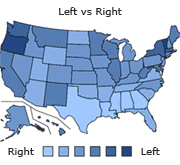Personality Quiz
A volcano is an opening, or rupture, in a planet's surface or crust, which allows hot, molten rock, ash and gases to escape from below the surface. Volcanic activity involving the extrusion of rock tends to form mountains or features like mountains over a period of time. Volcanoes are generally found where tectonic plates pull apart or come together. A mid-oceanic ridge, for example the Mid-Atlantic Ridge, has examples of volcanoes caused by "divergent tectonic plates" pulling apart; the Pacific Ring of Fire has examples of volcanoes caused by "convergent tectonic plates" coming together. By contrast, volcanoes are usually not created where two tectonic plates slide past one another. Volcanoes can also form where there is stretching and thinning of the Earth's crust (called "non-hotspot intraplate volcanism"), such as in the African Rift Valley, the Wells Gray-Clearwater Volcanic Field and the Rio Grande Rift in North America and the European Rhine Graben with its Eifel volcanoes.
An earthquake is the result of a sudden release of stored energy in the Earth's crust that creates seismic waves. Earthquakes are accordingly measured with a seismometer, commonly known as a seismograph. The magnitude of an earthquake is conventionally reported using the Richter scale or a related Moment scale (with magnitude 3 or lower earthquakes being hard to notice and magnitude 7 causing serious damage over large areas). At the Earth's surface, earthquakes may manifest themselves by a shaking or displacement of the ground. Sometimes, they cause tsunamis, which may lead to loss of life and destruction of property. An earthquake is caused by tectonic plates getting stuck and putting a strain on the ground. The strain becomes so great that rocks give way by breaking and sliding along fault planes.

